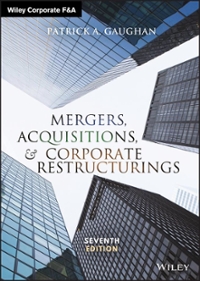Question
Case Study and Questions Andrew, a sole trader, aged 50, has been operating a machine manufacturing business for 17 years. He is thinking of selling
Case Study and Questions
Andrew, a sole trader, aged 50, has been operating a machine manufacturing business for 17 years. He is thinking of selling the business on 30 June 2018. His current business has assets with a net value of $2.5 million. If he sells the business assets there will be capital gains on goodwill of $600,000 and a factory (which he acquired 10 months ago) of $100,000.
Consider the following information:
Andrew and wife Suzie moved into their current home on 1 October 2014. It has a current value of $800,000 with a mortgage of $300,000.
Andrew has always operated a partnership with his brother out of a separate office in his home. This is 20% of the total area of the home.
Partnership business with his brother as equal partners, net value $1,400,000.
Andrew owns an investment property worth $1,400,000 (loan of $1,000,000)
Andrew owns shares in BHP worth $100,000
Andrew has superannuation fund interests of $500,000
Andrew owns 30% of Beaches Pty Ltd (net value of company is $3 million). Suzie owns 10% of Beaches Pty Ltd. An unrelated third party holds the balance of shares. This company operates as an advertising agency
Andrew is a beneficiary of the Beach Family Discretionary Trust. Andrew has not received any distribution of the capital or income of the trust, which currently has an asset value of $1.2 million.
Suzie is a successful legal consultant, and her business has a current value of $800,000. The business is operated under the structure of a unit trust where Suzie owns 98% of the units and Andrew owns the balance.
Andrew has come to you for advice on how to structure his exit from his business and what the capital gains tax consequences will be. Provide this advice through answering the following 4 questions.
1.Does Andrew satisfy the maximum net asset value test? If not, what could be done to ensure that Andrew satisfies this test? (8 marks)
2.Are the assets that Andrew proposes to sell "active assets" for the purpose of the small business CGT concessions? (1 mark)
3.If Andrew has a carried forward capital loss of $20,000 from last financial year and has used $350,000 of his retirement limit, what would be Andrew's net capital gain after the application of CGT small business concessions? (8 marks)
4.Write a note to Andrew setting out your recommendations from questions 1 to 3 above. (3 marks)
Step by Step Solution
There are 3 Steps involved in it
Step: 1

Get Instant Access to Expert-Tailored Solutions
See step-by-step solutions with expert insights and AI powered tools for academic success
Step: 2

Step: 3

Ace Your Homework with AI
Get the answers you need in no time with our AI-driven, step-by-step assistance
Get Started


